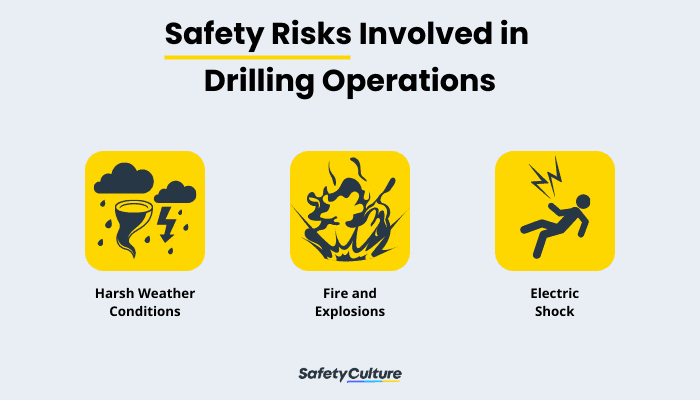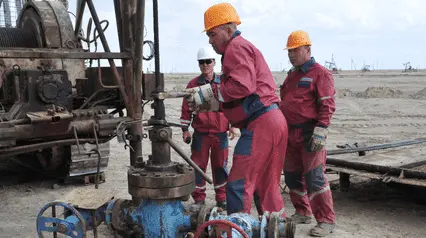What is Drilling Safety?
Drilling safety is a broad term that encompasses a variety of best practices and procedures designed to keep workers safe while operating drilling equipment. Among the many aspects of drilling safety, some of the most important is maintaining adequate training in the use of drilling equipment for all workers, following all safety protocols while operating the equipment, and regularly inspecting it to ensure that it is in good working condition.
Taking these steps will help companies prevent accidents and injuries at work. Drilling safety is crucial to any successful drilling operation, and following best practices and procedures can keep workers safe from harm.
What are Safety Risks Involved in Drilling Operations?
There are several risks associated with oil and gas drilling operations. Most of these risks involve working with heavy machinery that can be dangerous if not operated properly. Some common safety risks include:

Harsh Weather Conditions
A rig’s location and layout may expose it to natural hazards. Offshore, it can be storms and tides with humidity and sun exposure, but onshore, it is extreme heat or cold temperatures. They all can lead to equipment malfunction or the structure’s collapse.
In addition to physical safety, specific risks to certain locations can also affect employees’ mental and emotional well-being. For example, working long shifts in isolation or humid conditions and being exposed to excessive noise or heavy machinery can all lead to decreased attention span and increased accidents.
Fire and Explosions
The oil and gas industry is particularly vulnerable to fires and explosions due to the large quantities of flammable materials. A tiny spark or leak can easily lead to a major disaster.
The risk of explosions and fires increases in enclosed spaces, such as wellheads or tanks containing hydrocarbons. Poor quality equipment, incorrect use of tools, and ill-informed decisions can all lead to a fire or explosion.
Electric Shock
Drilling equipment requires electricity, and electric shock is always a risk. All electrical equipment must be correctly insulated and grounded before being used by workers to reduce the risk of injury.
Other risks include slips and falls, manual handling, hazardous materials, and improper operation of machinery. Following safety protocols and training workers on how to use drilling equipment can prevent these issues.
What are the 7 Steps in the Drilling Procedures?
Below are the seven steps commonly used in oil and gas drilling operations:
Preparing the Rig Site
With the construction of pads and access roads complete, drilling can begin. Traffic plans, noise barriers, safety procedures, etc., are all executed with precision and constantly monitored to ensure that they comply with state and local laws.
Drilling
After the drill rig is brought to the location and assembled—which takes around 20 or 30 truckloads—it’s finally time to start drilling for oil and natural gas. The well is plugged directly into the ground beneath the pad. The first stage is surface drilling, which goes down 100 feet below the deepest known aquifer, a body of rock holding groundwater. A steel casing surrounds the hole to prevent pollution.
An initial “long hole” is drilled to a depth of around 1,000 feet (about 304 meters), followed by a horizontal hole through the same rock bed for about a mile or two. Technology is needed to keep the hole from straying more than 10 feet (3.05 meters) from its original interval, but this allows the well to access energy across a much longer distance.
By horizontal drilling, drillers can use only one drilling pad for numerous wells, reducing the impact and scope of aboveground land disturbance.
Cementing and Testing
After attaining the target distance, extracting the drill pipe, and pushing the steel pipe to the bottom, this “well casing” is cemented. Natural gas and oil production can’t begin until several tests verify that the pipe doesn’t leak.
Well Completion
Before drillers can extract oil and natural gas, they must lower a perforating gun into the ground and shoot it at the rock layer in the deepest part of the well. It creates holes that connect the rock holding oil and natural gas with the wellhead.
Fracking
After opening the first stage of the well, it’s time to get the oil and gas trapped within the rock by pumping fracking fluid, which is 99.5 percent water and sand, with 0.5 percent chemicals, into perforating holes at high pressure, creating cracks in the shale rock that release oil and gas stored within. Monitoring this process closely with specialized instruments ensures optimal results.
Fracking is repeated until the entire wellbore has been fracked, which could take 20 to 30 times. Although it might sound like a long process, it typically only takes a few days from start to finish.
Production and Fracking Fluid Recycling
Production begins after fracking. Oil and natural gas come up from the well bore. Fracturing fluid is saved and used again in other fracking operations.
Well Abandonment and Land Restoration
Once the well stops producing oil or gas, it must be decommissioned and abandoned. It involves removing all surface infrastructure, such as steel pipes, and restoring the land to its original state. This final step is a crucial part of the entire process, preserving the environment in a healthy, intact condition.
Digitize the way you Work
Empower your team with SafetyCulture to perform checks, train staff, report issues, and automate tasks with our digital platform.
Get Started for FreeWhat Precautions Should Be Taken to Prevent Accidents in Drilling Operations?
In an emergency, Occupational Safety and Health Administration (OSHA) requires that every drilling site have a response plan. The necessary actions will vary depending on the rig’s location and layout. Drilling safety precautions include:
- Fall Protection – To avoid falling, examine your work surfaces and be aware of uneven terrain or areas with slippery conditions. Utilizing the proper materials for the job at hand can also help reduce the risk of a fall.
- Worker Identification Products – To ensure the safety of all workers, supervisors should implement wearable ID tags and routine shift check-in and check-out procedures. This way, emergency responders will always know the location of every worker on the rig.
- Adequate Productivity and Safety Tool Boxes – Oil and gas rig workers must have access to a toolbox with the appropriate equipment for repairs, and routine maintenance, which varies depending on the worksite. The types of equipment may include electrical parts, material handling aids, plumbing components, hand tools, and weld gear, among others.
- Emergency Response Plans – Using the proper equipment and being trained to handle blowouts can mean the difference between life and death and property damage.
- Detection Sensors – High-tech sensors are vital in detecting fires, smoke, and gas leaks to prevent explosions. Drilling operations must identify these hazards before they become more serious.
- Safety Lighting and Visible Signage – Due to the dangerous and challenging nature of drilling, lighting is vital for safety. It’s because some structures might need more light for visibility, and open pits are also present. Also, signage reminding workers of dangerous behaviors and access limits must be placed throughout the rig.
- Machinery Maintenance and Protection – Routine Maintenance, Repair, and Overhaul (MRO) are crucial to machine functionality, but special care must be taken with lockout/tagout procedures and energized or mechanical equipment. Guards, rails, and electrical surge protection prevent accidents, while safety toolboxes provide essential operating instructions.
- Regular Safety Training – Each drilling crew member must be taught the importance of safety. It includes covering evacuation procedures in a crisis, handling equipment and materials, and proper posture and footing (specifically at height or on slippery surfaces). In addition to helicopter crash survival and firefighting, they should learn to follow instructions and protocols rather than self-regulating safety risks.
- Non-stop Supervision – Since drilling operations are dangerous, an on-site supervisor is always necessary to mitigate the risk of human error.
- Adequate PPE in Good Condition – PPE, or Personal Protective Equipment, is an essential part of safety in drilling operations. Athletes’ foot cream for the monkey board, heavy-duty boots for slippery ground, hard hats, gloves, and goggles are always required. Moreover, waterproof garments, flame-resistant clothing, and hearing and respiratory protection are also necessary during drilling operations.
- Housekeeping Common Sense – Using common sense goes a long way in housekeeping at drilling sites, especially when preventing falls from small objects.
FAQs About Drilling Safety
The following PPE is required for all crew members on horizontal directional drilling job sites per OSHA and Vermeer guidelines:
- Eye protection
- Hard hats
- Hearing protection
- Safety shoes (steel-toe or composite-toe boots)
- Safety goggles
- Safety vests when working around roadways
- Leather gloves when changing out tooling or handling heavy materials
There are three primary types of drilling mud: water-based, oil-based, and synthetic-based. The drilling process may use any kind, or a combination of two or more, depending on the location and environmental regulations of the well.
Various types of wells can be drilled, each best suited for a different configuration of hydrocarbons. By adopting specific drilling strategies, you can place wells in optimized patterns to maximize production from a field. Below are the different types.
- Conventional wells
- Sidetrack wells
- Horizontal wells
- Designer wells
- Multilateral wells
- Coiled tubing drilling
- Through tubing rotary drilling
Anticipating problems and taking preventative action is essential to avoid costly delays. Some of the most common issues with drilling include:
- Pipe sticking
- Loss of circulation
- Hole deviation
- Pipe failures
- Borehole instability
- Mud contamination
- Formation damage
- Hole cleaning
- Hydrogen sulfide (H2S)-bearing zones
- Shallow gas zones
- Equipment and personnel-related problems




